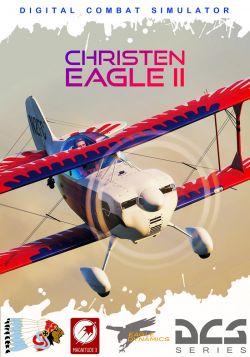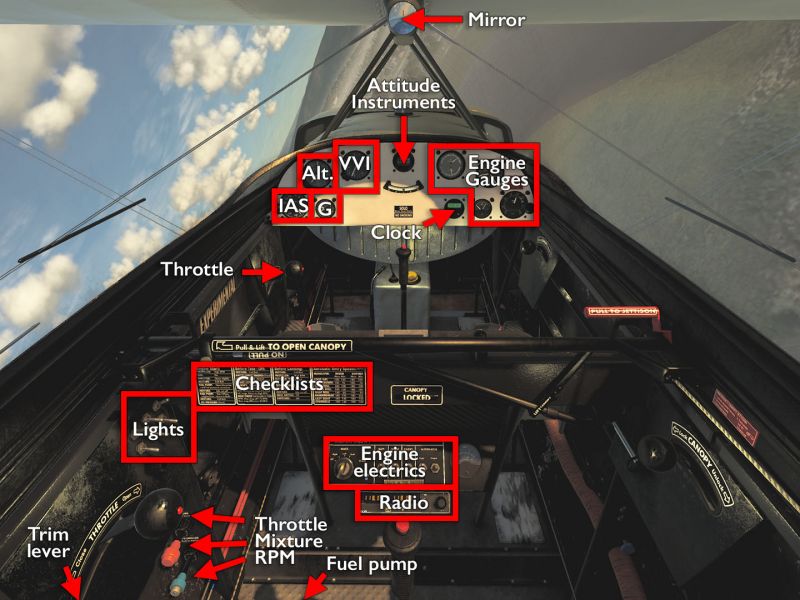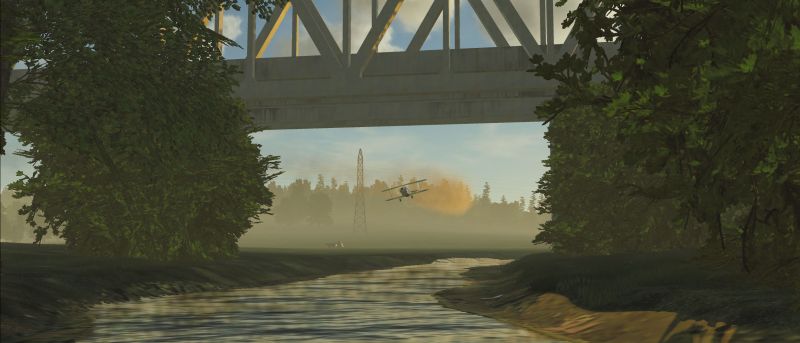Christen Eagle II
| This is an alpha module.
This module is still being developed and is missing central features and equipment options. While it is playable, it may have major bugs, and procedures may have inconsistent or unexpected results. The intrepid and very interested may want to buy it; others should probably wait for a more stable or complete release. |
The Christen Eagle II is an odd addition to the Digital Combat Simulator ecosystem. It is definitely not a combat aircraft, but it is also not really a training aircraft like the Yak-52 or the L-39C. It is a two-seater sporting biplane originally marketed as a homebuilding kit. It does not feature any of the instructor/trainee fault simulation or IFR training tools of those other aircraft, and while you can fly it in multicrew, it uses the classic biplane setup of pilot in the back, passenger in the front, and if you turn pilot models on, that front passenger will block the instruments.
What the CEII really is, is a tech demo and test bed for the new piston engine simulation Eagle Dynamics put into DCS, in much the same way as the Yak-52 was a platform for their radial-engine simulation. As a sim platform, the various DCS developers have on multiple occasions custom-built specific simulators for interested third parties, and this engine simulation gives them another tool in that particular toolbox for attracting new projects.
As for the airplane itself, it is a modern light-weight take on a classic tricycle biplane design — it is very stable and easy to fly, even when pushed beyond its flight envelope. Its post-stall behaviour makes it excel as an aerobatics plane.
Features
By virtue of what the CEII is, in reality as well as in the context of DCS, its feature list is rather short:
- A tail-dragging biplane built with modern designs that alleviate most of the issue those two features tend to entail.
- A light-weight steel and aluminium body with wooden wings, with nice creaking sound effects to match.
- Multicrew, for when you really want some poor VR passenger to suffer.
- A large number of fancy liveries, including some clever ones such as “Sopwith vs. Red Baron” and “Tomcat vs. MiG-28” for your mock aerial combat exhibitions.
- Enough of a damage model to let you lose different bits of the biplane wings, and have the whole thing flip out in new and interesting ways.
Missing features
The CEII is marked as early access in the DCS store because, as a test bed, it is not exactly receiving the full attention of the developer. The main thing it is meant to show off — the engine modelling — is in and fully operational, but a lot of the surrounding details are still left to be completed at some later stage.
- The manual is lacklustre and shallow in its description of most systems.
- The systems themselves (few as they may be) are lacking in detail outside of the core bits related to the piston engine.
- While some damage states are in, many are not, again mostly related to the half-finished systems.
- Most of all, it rather lacks a purpose.
Flying the Christen Eagle II
The Christen Eagle II has two main flying characteristics: it is slow and stable, but also slow and highly responsive. Its sporting and aerobatics credentials are top notch (as long as you do not assume that “sporting” means “fast”). Unless you really push it, it will do exactly what you tell it to, and even if it departs, it is very easy to recover. That slow speed means there is a lot of time to react, and you will have a hard time over-stressing the airframe.
That said, unlike the Yak-52 the CEII does have some rudimentary damage modelling, and will react to mistreatment. It cannot land on any surface the way the Yak can, for instance, but it is also not as binary where you are either flying perfectly fine, or you explode. In true biplane fashion, you can have upper or lower wings shot or ripped off and still be able to limp along — at this point, those kind and gentle flight characteristics go right out the window. It is very entertaining.
Cockpit overview
Getting into the air
With little in the way of systems that need to be set up, and with a tiny busy engine for hobbyist usage, the start-up procedure of the CEII is very simple:
- Turn battery and alternators on.
- Push propeller RPM and fuel mixture levers fully forward (“High RPM” and ”Full Rich,” respectively).
- Turn fuel on and use the manual pump to build up pressure.
- Open the throttle slightly.
- Pull the mixture level fully aft in preparation for engine crank.
- Turn magnetos to “start,” and as the engine catches, turn it to “both” while pushing the fuel mixture to Full Rich again.
Then you just have to let the engine warm up, set trims to neutral, and taxi to take-off, bearing in mind the usual quirks of how tail-dragging planes control on the ground, albeit much less so in the case of the CEII.
Shooting something
Ehhhm… no. Unless you count the taran as a weapon.
Links and files
- DCS: Christen Eagle II by Magnitude 3 LLC in the DCS shop.
More information
- Aviat Eagle II (previously the Christen Eagle II) on wikpedia.





